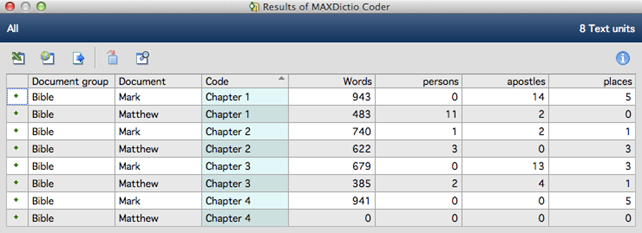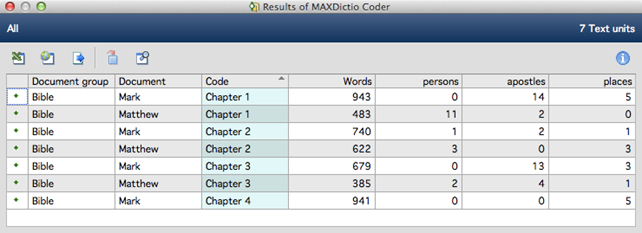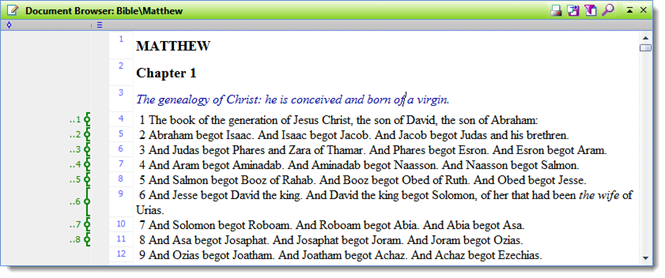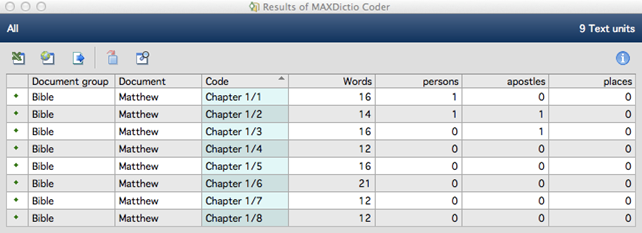 |
Results Table for Structured Texts
When analyzing structured texts, the analysis is itemized by the existing (or selected) text units. In the example above, the text has been differentiated by chapters. Suppose we want to analyze two texts, the first text consists of four chapters, the second of only three. In this case, the table of results still will be comprised of two times four lines (total: 8 lines), as in the illustration below. Here the text “Matthew” only consists of three text units, a fourth chapter didn’t exist. This is visible by the entry 0 in the last line in the column “Words” of the table of results (Matthew Chapter 4).

The results of the autocoding are shown in a table with 8 lines, where the entry “0” in the column “Words” indicates that there exists no “Chapter 4” in the document “Matthew”
There are cases, in which it is not desired to create empty lines for non-existing text units. This can be prevented by selecting the appropriate setting in the options menu.

In the “Options” menu, you can set whether blank text units should be included
Now only the actual existing text units will be counted and listed. The illustration below consequently contains only 7 lines; the first line for the non-existing Chapter 4 has been left out.

As soon as you check the option to only show existing text units, the empty rows in the table disappear
Many diverse possibilities result from subdividing texts on a more differentiated level. Analogue to a book, you can divide a text into:
Chapter 1 – Paragraph 1
Chapter 1 – Paragraph 2
Chapter 1 – Paragraph 3
Chapter 2 – Paragraph 1
Chapter 2 – Paragraph 2
Now you can carry out the analysis on the lowest level of the text – the paragraphs. To do this, select level 2 as coding depth. Even after differentiating a text this way, there still remains the possibility to analyze the text on the first level. Then the text will be counted on the level of the chapters. This only functions if there are no allocations to the first order codes “Chapter 1” or “Chapter 2;” the text must be coded consistently on the lowest level. This means that MAXDictio demands proceeding the same as when making a book. If a chapter is subdivided, each chapter starts with the first sub-chapter. Hence, there are no paragraphs that do not belong to a sub-chapter.
Example:
The text below has been processed so that each sentence in the chapters has been coded individually, beginning with the codes “Chapter 1/1,” “Chapter 1/2,” and so on.

Visualization of the coded sentences in the “Document Browser”
The results for the first 8 sections that have been analyzed with coding depth 2, appears as follows:

You can see that each sentence has been counted individually and the results are represented by an individual line in the table. In the first sentence of Chapter 1, for instance, 17 words have been counted and in sentence 2 there were 15.
 Further Processing of the Coder
Results with Excel or SPSS
Further Processing of the Coder
Results with Excel or SPSS
© VERBI Software. Consult. Sozialforschung. GmbH, Berlin 2014, v11.1.0 |